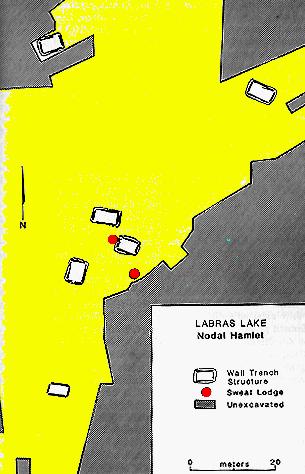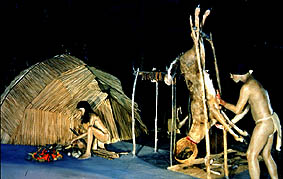
Sweatlodges at Labras Lake site.
Initially such tributes may have been freely given, but later they may have
become expected from commoners. Over time the entrenchment of prestigious
people may have become more pronounced and the character of this movement of
goods may have become more fixed. In either case the chief's power likely
stemmed from both ritual threats and physical power of his loyal followers.
|
The most obvious archaeological expression of local chiefs' economic power (as
well as social and religious power) are
villages with one or two small mounds surrounded by a scattering of smaller
settlements. Someone in the village was able to accumulate enough wealth and
respect to organize the population and have the mounds built. Not all villages
in the American Bottom contain mounds, but excavations have revealed the
presence of civic or ceremonial buildings such as circular sweatlodges and
pots, and ornaments more finely made than those found in surrounding hamlets.
These so-called "nodal sites"
appear to represent the economic integration of the local community of closely
related households scattered in nearby hamlets. Although individual households
in these scattered farmsteads were probably self-sufficient and largely
autonomous, they no doubt had certain social obligations. Some of their family
food surplus, for example, may have been required for local social and
religious functions that they attended at the local leader's settlement (whose
larger and more numerous sweatlodges could accomodate more people).
Similarly, some of the resources accumulated by these local chiefs must have been required for more inclusive ceremonies at larger mound centers. Stored foodstuffs, beads fashioned from shell, and other goods may have been transported by the lesser chiefs for social and religious events presided over by more powerful chiefs. Although simple, this socially mandated movement of goods and/or services from the hamlet - to nodal site - to small mound site - to large mound center is the basis of the chiefdom. It was the basis of integrating the American Bottom Mississippian economy.

Reconstructed sweatlodge, Cahokia Mounds Museum.
|

